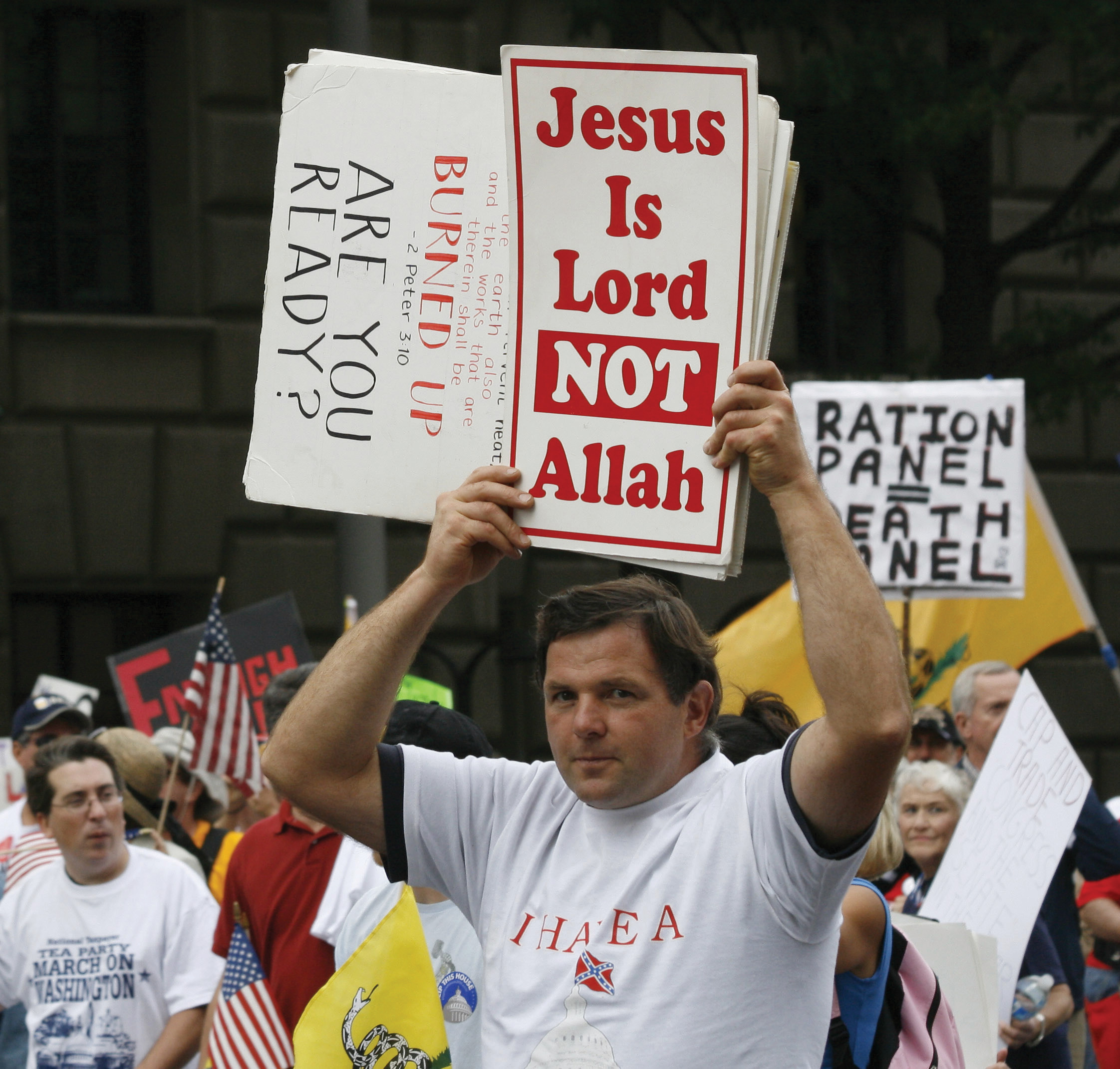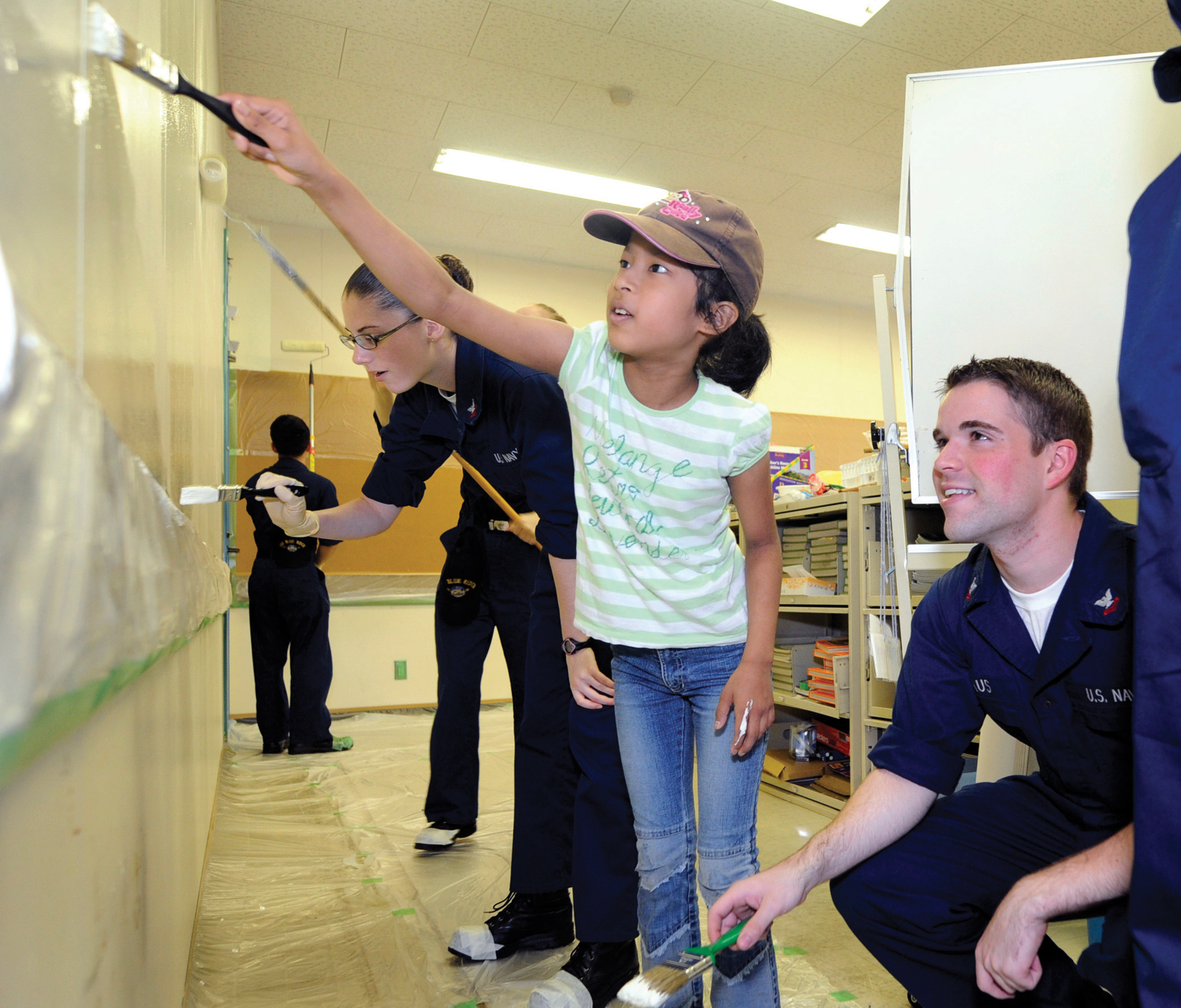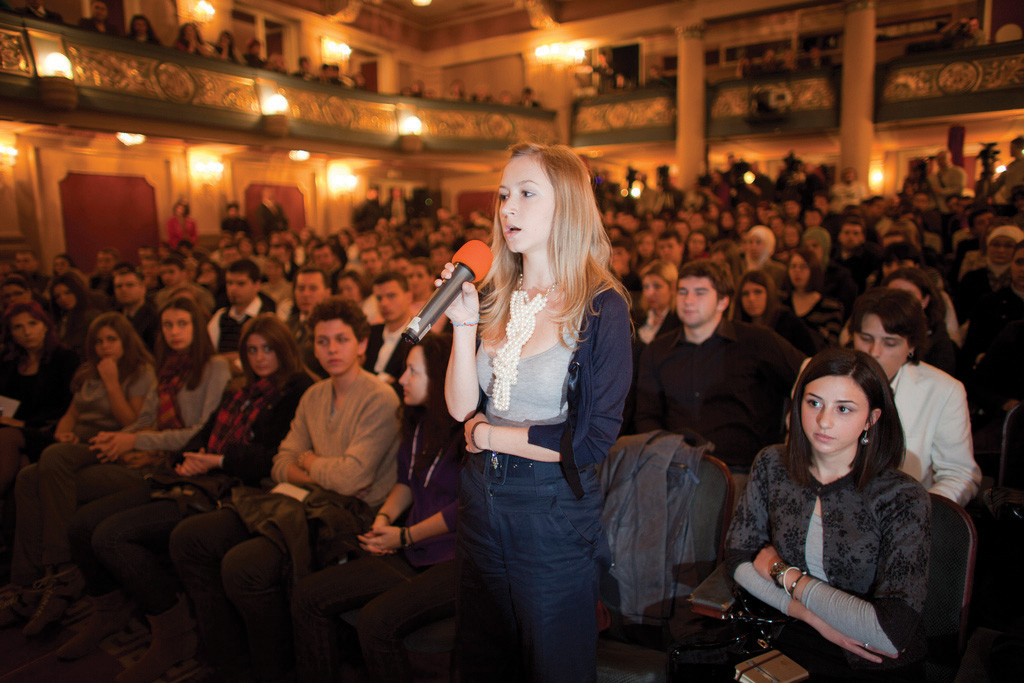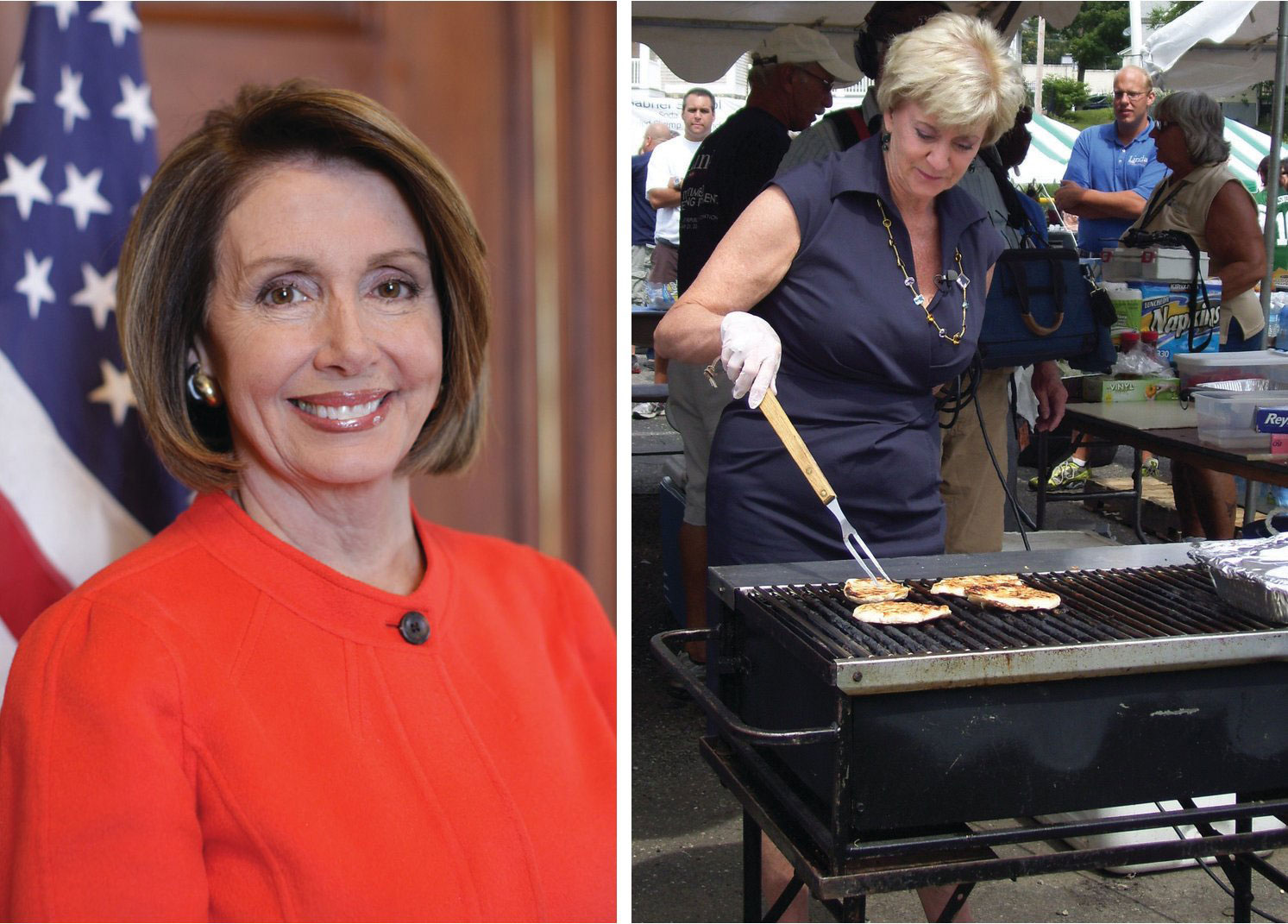Learning Objectives
After reading this section, you should be able to answer the following questions:
- How do people become politically mobilized?
- How interested are Americans in taking part in politics?
- What types of people are the most and the least likely to participate in American government and politics?
- What barriers to political participation are faced by some groups?
People get involved in politics for a variety of reasons. They may be personally motivated because of an event that changed their lives. They may receive invitations to participate from friends, organizations, political parties, or a candidate’s campaign. A person’s socialization, life experience, and attitudes toward politics can influence participation. Some people have a strong sense of civic duty and a belief that they can influence government, which compels them to act. Barriers, such as legal obstacles, may preclude some people from engaging politically.
Mobilization Efforts

Most people do not wake up one morning and decide that they are going to engage in politics. They must be motivated to participate, often by people or organizations reaching out to them and asking them to get involved. Increasingly people received digital invitations to participate through Facebook groups formed by friends, e-mail solicitations from campaigns and interest groups, and podcasts from political organizations.
Traditionally, political parties helped mobilize people by recruiting volunteers for campaigns and other political events. Parties provided a training ground for candidates and leaders and rallied people around issues. Today, parties’ role in directly mobilizing people to participate in politics has diminished. People are more inclined to support a candidate who represents their interests than a political party (Dennis & Owen, 1997).
Interest groups and candidates’ campaigns can encourage people to take part in politics. They use marketing strategies to target potential activists based on demographic characteristics and political orientations. Organizations acquire lists of prospects from political parties and market research firms, and they use these lists to contact people by mail, telephone, and e-mail (Schier, 2000). They can microtarget supporters based on specific characteristics, such as voters who are in their twenties, drink Starbucks coffee, enjoy Judd Apatow films, and work in the legal field.
Trade unions mobilize blue-collar workers, especially on behalf of the Democratic Party. Black churches are instrumental in organizing political action in the African American community, fundamentalist congregations provide a base for the Christian Right, and the Catholic Church helps mobilize the pro-life movement against abortion and anti–death-penalty activists.
Socialization and Life Experience
People can establish the habit of participating in politics through political socialization, the process by which people acquire their political beliefs, attitudes, and actions. Political experiences with families, schools, friendship groups, churches, community organizations, and mass media can motivate people to become lifelong political participants. If your parents are community activists there is a good chance that you also will be active at some point in your life (Merelman, 1984). People can be socialized to participation through civic education when they learn in school how democracy works and how they can take part. Students can gain experience by participating in extracurricular activities, student government, or community volunteer programs. These activities place young people in social and political networks with others who have a strong sense of civic duty, the belief that one has a responsibility to take part in community life.
People’s integration into their communities is strongly related to their level of political activity. Those who are mobile and have not established community roots find it more difficult to participate in politics because they are not part of a social network. It takes about three to five years to develop friendship networks, learn about the problems facing a community, and identify which people are the key players (Conway, 2000).
Difficult life experiences can cause people to act who never thought they would become involved. President Bill Clinton pardoned Dorothy Gaines and Kemba Smith, who had received long mandatory prison sentences on drug charges with no hope of parole. They were not involved with drugs but had boyfriends who were dealers. It is a crime under federal law to associate with known drug dealers. Ms. Gaines lobbied for her freedom from her jail cell, working with civil rights organizations, and she drew media attention to her problem, including a widely read article in People magazine. Kemba Smith’s father, Gus, an accountant who had never been politically active, worked to secure his daughter’s release. A cover story in Ebony magazine rallied support for her case, and a film was made about her life. Since the pardons, Dorothy Gaines, her father, and Kemba Smith have continued to lobby for changes in the sentencing laws. Kemba Smith has established a foundation to educate young people about making proper decisions.
Attitudinal Factors
People’s attitudes about government and politics can influence their decision to participate. People who have a strong sense of political efficacy, are interested in politics, and have a sense of civic duty are more likely to participate. Political efficacy is the belief that you personally can make a difference in governmental affairs (Verba & Nie, 1972). During the 2008 presidential election, people who believed that their vote could make a difference were more likely to cast a ballot than those who felt that their vote didn’t matter.
Americans’ interest in politics had declined for about two decades beginning in the 1980s. Only about one-quarter of the public in 2000 expressed much interest in the presidential campaign, and there was even less interest in other aspects of politics. Only about 40 percent of citizens felt strongly that voting was an important civic duty. The 2008 presidential campaign bucked this trend: around 80 percent of the public expressed interest in the election and over 60 percent considered voting to be their civic duty. Americans are typically less interested in nonpresidential elections. Forty-three percent of the public claimed to be interested in the 2010 congressional midterm elections (Pew Research Center for the People and the Press, 2010).
Political interest has been bolstered by the ability of people to take part in politics and express their opinions more easily through digital media. People feel like they have a greater say in government and can reach out to leaders through e-mail and online discussion forums. Political leaders have established social media accounts on Facebook and Twitter in order to share information and to enable greater interaction with their constituents. “U.S. Politics on Facebook” provides a gateway to the pages of politicians, elected officials, and political campaigns.
Personal Gratification

The expectation that political participation will be rewarding can spark people to become active. Some people are motivated by the belief that they will be connected to powerful leaders and receive material benefits, such as a chance to further their careers or get help with a personal problem. Others embrace the opportunities to meet people and socialize while working together, or they are happy to do something good for the community. High schools and colleges throughout the nation have instituted community service programs to stimulate lifelong participation based on the personal gratification students experience when they realize that their efforts make a difference.
Who Participates and who does not?
Meaningful and regular opportunities for all people to participate must be guaranteed by a democratic political system, whether or not everyone chooses to take part. But not all Americans take part in politics, nor are the opportunities for participation equal. Voters and political activists generally are older, more educated, and better off financially than the general population. These people have the best chance of having their views represented in government. Meanwhile, those who rely the most on government programs and policies, such as recipients of public assistance, often have fewer opportunities to participate and are less engaged.
Socioeconomic Status
Socioeconomic status (SES) is determined by people’s levels of education, income, and occupation. Wealthier and better educated people tend to vote more often, participate more in political activities, and donate more money to causes than poorer or less educated people. They also have greater access to the resources that facilitate political activity, including contacts with people in powerful positions. People’s occupations also are related to their participation, as people in managerial and professional positions are the most politically active, followed by craftspersons, service workers, and laborers. Many managers and professionals follow politics as part of their jobs. The unemployed are the least inclined to take part.
Education has the strongest impact on participation, as it provides people with background knowledge of how the political system works. Educated people develop the skills that allow them to follow and understand events through the mass media. They are likely to form opinions about political issues and engage in discussions. The political blogs with the most readers, such as Daily Kos and Huffington Post, are written and read by well-educated people (Hindman, 2008). Education prepares people to deal with the bureaucratic aspects of participation, such as registering to vote or organizing a petition drive. Eighty-three percent of people with graduate school education voted in the 2008 presidential election compared with 39 percent of those without a high school diploma (McDonald). The 2010 midterm elections were decided primarily by people with at least some college experience. Less than 5 percent of voters had no high school education, 16 percent were high school graduates, 29 percent had some college, and 50 percent were college graduates (Klein).
Age

Political participation differs notably by age. People between the ages of thirty-five and sixty-five are the most politically active. At this stage in life, people are more likely than younger people to have established homes, hold steady jobs, and be settled into communities. Those with stable community roots often have strong incentives and greater resources for becoming involved in politics.
While younger people turn out in elections less often than older people, youth voting has been on the rise in presidential elections since 2004. Turnout among eighteen- to twenty-four-year-olds dropped from 50 percent in 1972, the first presidential election year after the voting age was lowered to eighteen, to 36 percent in 2000. Turnout among senior citizens, people sixty-five and older, increased to nearly 70 percent in that same time period (Project Vote-Smart). Young voter turnout rose to 47 percent in 2004 and 51 percent in 2008, partly as a result of voter registration and mobilization efforts by groups like Rock the Vote. The youth vote contributed to the success of Democratic presidential candidate Barack Obama in 2008, as young volunteers provided countless hours of campaign support (Center for Information & Research on Civic Learning and Engagement). Information about young voters can be obtained from the Center for Information & Research on Civic Learning and Engagement.
People under the age of thirty are among the least involved in mainstream forms of participation. Young people often lack the money and time to participate. Still, many young people realize that participation matters. Reacting to problems they see in their hometowns, youth have formed groups to work for change. They have successfully lobbied government officials, spoken out at public meetings, and provided formal testimony at hearings. Young people have established safety policies in schools, protested against increases in college tuition rates, and prompted the creation of recreational facilities for biking, skateboarding, and ice hockey.
Gender
Political scientists and journalists often talk about the gender gap in participation, which assumes women lag behind men in their rates of political engagement. The gender gap is closing for some forms of participation, such as voting, but still exists for activities such as running for office.

Women turn out to vote more frequently than men. Since 1986, women have exceeded men’s turnout rate in presidential elections. Sixty-six percent of women cast a ballot in 2008 compared with 62 percent of men. Women have a strong sense of civic duty and believe that voting is a citizen’s obligation. The prominence in campaigns of issues of importance to women, such as abortion, education, and child welfare, also encourages women to vote (Seltzer, Newman, & Leighton, 1997).
Since the 1990s, women have been as likely as men to contact members of congress, sign and circulate petitions, attend local political meetings, and donate their time to political causes. They take part in local and state political activities more than in the national realm, where most media attention is focused. However, women are somewhat less inclined than men to use new media, such as online news sites and blogs, for politics.
A significant gender gap in participation exists for running for and holding political office. While women make up more than half the population, they constitute far less than half of the elected officeholders, especially at the national level. A total of 274 women have served in Congress since 1917, when Jeannette Rankin (R-MT) was the first woman elected to Congress. A record number of women—over 270—ran in the congressional primaries in 2010, although many were not successful in their bids. There are 75 female House members in the 112th Congress, constituting 17 percent of the 435-member body, which is a historical high. Eighteen of the one hundred senators are women (Office of the Clerk).
There is little evidence today that female candidates have a harder time attracting fair news coverage, raising money, or getting votes than male candidates running as challengers or for open seats. In the 2010 midterm elections, some of the best-funded candidates were women. However, women candidates often face male incumbents, candidates already in office, who are difficult to defeat (Darcy, Welch, & Clark, 1994). Motherhood becomes an issue for women who seek or hold public office. The 2008 Republican vice presidential candidate, Sarah Palin, faced scrutiny by the press and voters because she was the mother of five children, including a four-month-old baby with Down syndrome.
Race and Ethnicity
Participation differs among members of racial and ethnic groups. Specific patterns of participation are associated with blacks, Latinos, and Asian Americans and Pacific Islanders.
Blacks
Discriminatory practices kept black voter turnout low until after the passage of the Voting Rights Act of 1965. Poll taxes, fees that had to be paid before a citizen could register to vote, disenfranchised the poor, many of whom were black. Literacy tests, which required people to demonstrate their ability to read, write, and interpret documents prior to voting, were applied unfairly to blacks. The “white primary” restricted voting in Democratic primaries to whites in certain Southern states. The Southern Democratic party was so dominant that winning the primary was tantamount to election to office. Intimidation and violence by groups such as the Ku Klux Klan kept black voters from the polls. Eventually, civil rights protests and litigation resulted in the elimination of formal barriers to voting. Today, black citizens vote at least as often as white citizens who share the same socioeconomic status. Sixty-five percent of black voters turned out in the 2008 presidential election compared with 66 percent of white voters. Over 90 percent of black voters supported African American candidate Barack Obama (McDonald).
Black and white Americans are about equal in how much time and effort they devote to activities other than voting. However, they differ in the types of activities in which they engage. Whites are more likely to contact public officials and join political organizations. Black citizens are active in election campaigns and social movements.
Latinos
The Latino population in the United States is well established and has grown to over 47 million people from diverse countries of origin. Although they form a substantial political bloc, only 49 percent of eligible Latino voters turned out in the 2008 presidential election. Latinos tend to participate in other forms of political activity with less frequency than either white or black citizens. In 2010, however, three Latino candidates were elected to top offices, including two governors and one senator, for the first time in history. The Pew Hispanic Center provides information and data on Latino American politics.
Language is one barrier to Latino participation. Candidates recognize that Latinos constitute a large and growing voting bloc and have begun campaigning in Spanish. During the 2000 presidential election campaign, candidate George W. Bush ran nearly as many ads in Spanish as in English (Schriefer, 2001). The 2008 presidential candidates’ websites featured extensive Spanish-language content, as did the websites of a good number of congressional candidates in 2010.
Asian Americans and Pacific Islanders
According to the US Census, Asian Americans and Pacific Islanders are the fastest growing and most diverse ethnic group. Yet their rates of participation are lower than for other groups. In 2008, 48 percent of Asian Americans turned out to vote (Hess). Cultural factors contribute to the lower levels of Asian American and Pacific Islander voting. Some are recent immigrants who still maintain strong ties to their ethnic culture. Asian Americans who have been victims of hate crimes or consider themselves to be part of a deprived group find their way to the polls in greater numbers (The White House Commission on Asian Americans and Pacific Islanders, 2001).
Key Takeaways
People often are motivated to participate in politics because they are targets of mobilization efforts by political parties and interest groups. They also can acquire the habit of participating politically through the process of political socialization or have a life experience that prompts them to act. Political attitudes such as civic duty and a sense of political efficacy can influence a person’s decision to participate. People may seek personal gratification through political action, as they enjoy working with others and helping their community. Legal factors such as voter registration requirements can impede participation. Who participates in politics depends on a variety of factors, including socioeconomic status, age, gender, and race and ethnicity. Those with the most money, time, and skills are more likely to participate. Older people with higher education and income are the most likely to vote and take part in politics. People who have the least in society, and who are most in need of government assistance, are often the most poorly equipped to take action to improve their lot.
Exercises
- Are you aware of interest groups’ and political campaigns’ efforts to mobilize you? What techniques do they use to try to reach people like you?
- Why do you think Americans have become less engaged in politics? Why do you think they were more engaged during the 2008 election?
- Which groups are the least likely to participate in politics? What are the obstacles to participation that these groups face?
- What effect do you think it has on politics that some groups participate more than others? What effect do you think it has that there are relatively few women in Congress?
References
Conway, M. M., Political Participation in the United States, 3rd ed. (Washington, DC: CQ Press, 2000).
Dennis, J. and Diana Owen, “The Partisanship Puzzle,” in After the Boom: The Politics of Generation X, ed. Stephen C. Craig, and Stephen Earl Bennett (Lanham, MD: Rowman & Littlefield, 1997), 43–61.
Merelman, R. M., Making Something of Ourselves (Berkeley: University of California Press, 1984).
Pew Research Center for the People and the Press, “Pew Weekly News Interest Index Poll, Oct, 2010,” Poll Database, http://people-press.org/questions/?qid=1772828&pid=51&ccid=51#top: “Thinking about this year’s (2010) Congressional elections, would you say that you are interested in what’s happening in elections around the country?”
Schier, S. E., By Invitation Only: The Rise of Exclusive Politics in the United States (Pittsburgh, PA: University of Pittsburgh Press, 2000).
Verba, S. and Norman H. Nie, Participation in America: Political Democracy and Social Equality (New York: Harper & Row, 1972).
Center for Information & Research on Civic Learning and Engagement (CIRCLE), “Youth Voting,” http://www.civicyouth.org/?page_id=241#1.
Darcy, R., Susan Welch, and Janet Clark, Women, Elections, and Representation (Lincoln: University of Nebraska Press, 1994).
Klein, E., “Who Graduates, Who Votes and Who’s Unemployed—in the 2010 Midterm Elections,” washingtonpost.com, http://voices.washingtonpost.com/ezra-klein/2010/12/who_graduates_who_votes_and_wh.html.
Hess, D. R., “Analysis of the 2008 Current Population Survey (CPS) Voter and Registration Supplement,” http://www.projectvote.org/images/publications/Reports%20on%20the%20Electorate/Analysis%20of%20the%202008%20CPS%20Voting%20Supplement.pdf.
Hindman, M., The Myth of Digital Democracy (Princeton, NJ: Princeton University Press, 2008).
McDonald, M., “Current Population Survey Voting and Registration Supplement,” United States Election Project, http://elections.gmu.edu/CPS_2008.html.
Office of the Clerk, US Capitol, Women in Congress website, http://womenincongress.house.gov.
Project Vote-Smart, Democracy Inclusion Project, http://www.vote-smart.org/yip.
Schriefer, R., Bush campaign media consultant, interview by Owen, May 22, 2001.
Seltzer, R., Jody Newman, Melissa Vorhees Leighton, Sex as a Political Variable (Boulder, CO: Lynne Reinner, 1997).
The White House Commission on Asian Americans and Pacific Islanders, A People Looking Forward (Washington, DC: US Government, 2001).

